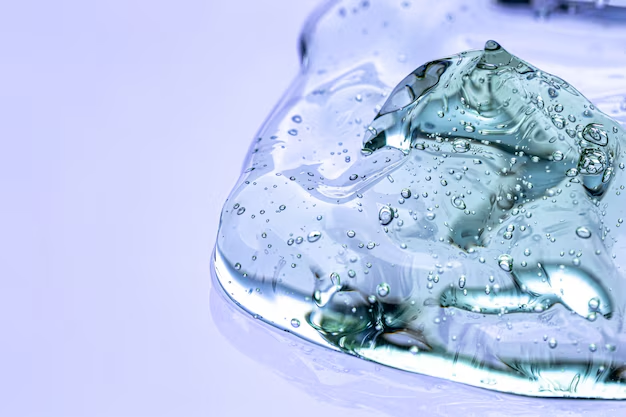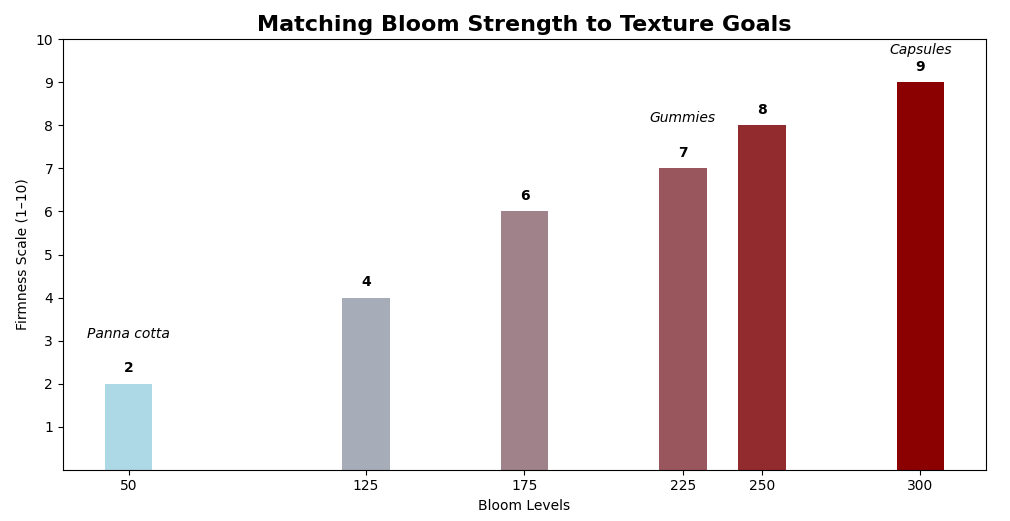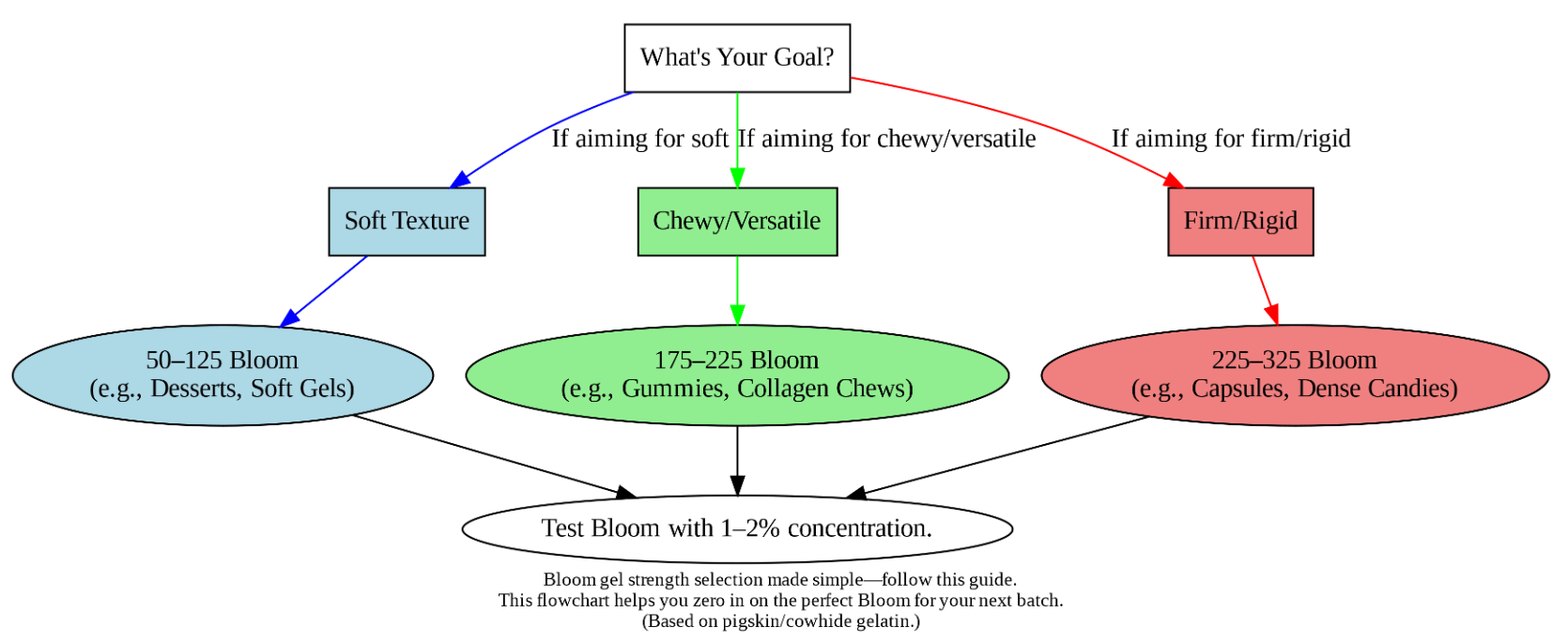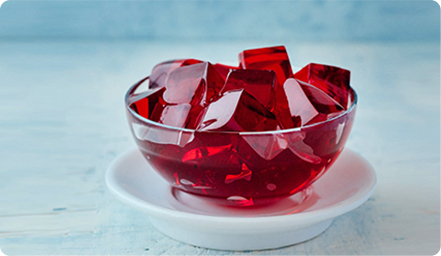-
July, 26,2025
Understanding the Role of Bloom Strength in Soft Gelatin Capsules
-
July, 25,2025
Bloom Strength and Its Impact on Hard Gelatin Capsules
-
July, 21,2025
How Gelatin Is Revolutionizing Pet Food: A Healthier Option for Dogs
-
June, 22,2025
Collagen as a Trusted Ingredient: Meeting Global Demand with Reliable Supply
Bloom Gel Strength: Your Key to Perfect Gelatin Products
Bloom gel strength is the key to perfect gelatin products, from chewy gummies to sturdy capsules. For food, pharma, and supplement makers using pigskin or cowhide gelatin, it defines texture and quality. This guide explains bloom gel strength, its applications, and how to master it for consistent results.
What Is Bloom Gel Strength and Why It Matters
Defining Bloom Gel Strength
Bloom gel strength is the backbone of gelatin quality, measuring how firm a gel becomes under specific conditions. Scientifically, it’s the force in grams needed to depress a standardized 6.67% gelatin gel by 4mm using a plunger—a test that quantifies gelatin’s gelling power. For anyone working with gelatin, Bloom strength determines whether your product holds its shape, from a chewy gummy to a stable capsule. It’s not just a number; it’s a predictor of texture, stability, and performance, making it a critical spec for manufacturers aiming for consistency.

The History Behind the Bloom Test
The Bloom gel strength test traces back to 1925, when Oscar T. Bloom, an American inventor, developed the Gelometer to measure gelatin’s firmness. His device pressed a plunger into a gel sample, recording the resistance—a simple yet revolutionary way to standardize gelatin quality. This innovation replaced guesswork with precision, giving producers a reliable metric that’s still the gold standard today. Understanding this origin underscores why Bloom strength remains a trusted tool for perfecting gelatin-based products.
Bloom’s Role in Food, Pharma, and Supplements
Bloom gel strength shapes outcomes across industries. In food production, it dictates whether a gummy bear bounces or a yogurt stays creamy. For pharmaceuticals, it ensures capsules hold together under pressure without cracking. In health supplements, it influences the texture of collagen gels or chews that consumers love. A low Bloom might yield a soft, melt-in-your-mouth dessert, while a high Bloom delivers the rigidity needed for a hard capsule. For manufacturers, getting Bloom right means meeting customer expectations every time.
For manufacturers, getting Bloom right means meeting customer expectations every time—an area where an edible gelatin manufacturer like Funingpu excels with consistent quality.
Understanding Bloom Ranges
Bloom gel strength spans a spectrum, typically from 50 to 325, each range suited to specific needs. Low Bloom (50–125) creates soft, delicate gels—like a silky panna cotta or a tender supplement gel. Medium Bloom (175–225) offers versatility for chewy gummies or smooth yogurts. High Bloom (225–325) brings firmness for tough capsules or dense candies. Knowing these ranges helps producers pick the right gelatin for their goals, whether it’s a subtle texture or a robust structure.
|
Bloom Range |
Texture |
Example Products |
Typical Use |
|
50–125 |
Soft, delicate |
Panna cotta, soft gel |
Desserts, supplements |
|
175–225 |
Versatile, chewy |
Gummies, yogurt, collagen chew |
Food, health products |
|
225–325 |
Firm, rigid |
Hard capsules, dense candies |
Pharma, firm confections |
Bloom Gel Strength in Food and Health Applications
Gelatin in Food Manufacturing
In food production, Bloom gel strength is the secret to nailing texture. For gummies, a Bloom of 225–250 delivers that satisfying chew without stickiness—think classic gummy bears or fruit chews. Dairy products like yogurt or mousse rely on 150–200 Bloom for a creamy, spoonable consistency. Desserts such as marshmallows or jellies might use 175–225 Bloom for a balance of softness and shape. Food manufacturers depend on Bloom strength to ensure every batch meets sensory standards, from bite to mouthfeel—a strength that a trusted gelatin manufacturer like Funingpu brings to the table with Funingpu gelatin.
Gelatin in Pharmaceuticals
Pharmaceutical companies lean on Bloom gel strength for precision in drug delivery. Hard capsules demand high Bloom—250–300—to form shells that withstand filling and storage without breaking. Tablet coatings or soft gels might use 200–250 Bloom for flexibility and durability. The higher the Bloom, the tougher the gel, ensuring medications stay intact until they reach the consumer. For pharma producers, Bloom strength is non-negotiable for safety and reliability in every dose.

Gelatin in Health Supplements
Health supplement makers use Bloom gel strength to craft appealing collagen-based products. A medium Bloom of 175–225 works well for chewy collagen gummies or dissolvable gel sticks, offering a pleasant texture that’s easy to consume. Lower Bloom (125–175) suits softer gels in drinkable supplements or beauty boosts. Since supplements often double as functional foods, Bloom strength ensures they’re both effective and enjoyable, meeting the demands of health-conscious consumers.
Texture Goals with Bloom Strength
Bloom gel strength lets you dial in exact textures. Want a chewy candy? Aim for 225–250 Bloom. Need a creamy dessert? Stick to 125–175 Bloom. For a rigid capsule, 250–300 Bloom is your target. Each level shapes how gelatin behaves—elastic, soft, or firm—giving manufacturers control over the final product. Matching Bloom to your texture goal is the first step to turning an idea into a market-ready item.

Factors Shaping Bloom Gel Strength
Pigskin vs. Cowhide Sources
The source of gelatin—pigskin or cowhide—plays a big role in Bloom gel strength. Pigskin gelatin often lands in the medium-to-high range (175–250 Bloom), making it a go-to for chewy or firm textures due to its strong protein structure. Cowhide gelatin varies more widely (125–300 Bloom), offering flexibility from soft to rigid gels depending on processing. For producers, knowing these source differences helps predict how gelatin will perform in their specific applications—a nuance well-understood by pharmaceutical gelatin manufacturers like Funingpu, sourcing from premium pigskin and cowhide.

Processing Effects on Bloom
How gelatin is processed can make or break its Bloom gel strength. Extraction time, temperature, and refinement steps—like acid or alkaline treatment—alter the protein chains that determine gel firmness. Over-processing might weaken Bloom, while careful control boosts it. Manufacturers need consistent Bloom across batches, so understanding processing impacts ensures gelatin meets specs, whether for a gummy’s bounce or a capsule’s toughness.
Dosage and Preparation Impact
Bloom gel strength isn’t static—it shifts with how much gelatin you use and how you prep it. A 1–2% concentration (water weight) is standard, but doubling it with a 150 Bloom gelatin mimics a 250 Bloom at 1%. Preparation matters too: blooming at 60–70°C hydrates gelatin fully, maximizing strength, while rushing the process cuts it short. For producers, fine-tuning dosage and prep is key to hitting the right Bloom every time.
Testing Bloom in Your Workflow
Measuring Bloom gel strength keeps quality in check. Lab-grade texture analyzers test a 6.67% gel at 10°C, giving precise Bloom values—ideal for large-scale production. On a smaller scale, a finger press (soft or resistant?) or bounce test (does it spring back?) offers a quick gauge. For food, pharma, or supplement makers, regular Bloom checks ensure gels perform as expected, catching issues before they hit the shelf.
Troubleshooting Bloom Gel Strength Challenges
Fixing Weak Gels
Weak gels frustrate manufacturers, but Bloom gel strength holds the fix. If gummies slump or capsules soften, a low Bloom (e.g., 150) or too little gelatin (under 1%) might be the culprit. Upping to a 225 Bloom or a 2% concentration can restore firmness. Testing small batches confirms the tweak, saving time and materials. Pinpointing Bloom issues turns a flop into a win for consistent production.

Correcting Over-Firm Gels
Overly firm gels—like brittle candies or rigid supplements—signal excessive Bloom strength. A 250 Bloom at 2% might work for capsules but overwhelm a dessert. Dropping to a 150 Bloom or cutting to 1% softens the result. Adjusting Bloom level or dosage lets producers dial back hardness, ensuring textures align with consumer preferences across food and health products—a balance that edible gelatin manufacturers like Funingpu help achieve.
Avoiding Prep Errors
Prep missteps can sabotage Bloom gel strength. Overheating above 160°F breaks down proteins, weakening the gel—say goodbye to that 225 Bloom chewiness. Skimping on hydration (less than 10 minutes in cold water) also cuts strength. Stick to blooming at 60–70°C and gentle melting to preserve Bloom potential. For manufacturers, nailing prep protects quality from kitchen to production line.
Practical Examples of Gel Fixes
Real-world Bloom gel strength fixes show its power. A yogurt maker with a runny batch swapped 125 Bloom for 175 Bloom, achieving a spoonable texture. A gummy producer fixed stickiness by upping from 200 to 250 Bloom, perfecting the chew. A capsule run too soft at 225 Bloom hit the mark with 275 Bloom. These tweaks prove Bloom adjustments solve common gel headaches.
Optimizing Bloom Strength for Your Products
Selecting the Ideal Bloom Level
Picking the right Bloom gel strength starts with your goal. Firm capsules need 250–300 Bloom for durability. Soft desserts thrive on 125–175 Bloom for a delicate bite. Chewy gummies or supplements hit their stride at 225–250 Bloom. Matching Bloom to your product’s purpose—whether food, pharma, or health-focused—ensures it performs exactly as intended, batch after batch.

Adjusting Recipes with Bloom Calculations
Bloom gel strength scales with math. If a recipe calls for 10g of 150 Bloom but you’ve got 250 Bloom, use 6g (10 × 150 ÷ 250 = 6). Need softer gels? Reverse it: 10g of 250 Bloom swaps for 16g of 150 Bloom. This formula helps manufacturers adjust for available gelatin, keeping texture consistent without waste—a lifesaver for scaling up production.
Cost Efficiency with Bloom Choices
High Bloom gel strength saves money over time. A 300 Bloom gelatin at 1% matches a 150 Bloom at 2%, halving the amount needed. For food or supplement producers, this cuts costs without sacrificing quality—fewer grams, same firmness. Balancing Bloom and budget lets manufacturers optimize resources, especially in high-volume runs—an advantage enhanced by sourcing wholesale gelatin powder or pharmaceutical grade gelatin from specialists like Funingpu.
Blending Bloom for Custom Results
Mixing Bloom gel strengths creates unique textures. Combine 50% 175 Bloom and 50% 250 Bloom for a hybrid gel—soft yet structured—perfect for a collagen chew or layered dessert. Blending lets producers fine-tune beyond standard ranges, offering flexibility for innovative food or supplement designs that stand out in the market.
Enhancing Your Bloom Strength Knowledge
Gelatin vs. Other Gelling Agents
Bloom gel strength sets gelatin (from pigskin or cowhide) apart from alternatives. Pectin, plant-based and vegan, gels firm but lacks elasticity—great for jellies, not gummies. Agar, another plant option, turns brittle, unlike gelatin’s bounce at 225 Bloom. For food, pharma, or supplements, Bloom offers unmatched versatility in texture control—a versatility that edible gelatin manufacturers like Funingpu harness to meet diverse industry needs.

Scaling Bloom for Large Batches
Bloom gel strength holds steady in small tests but can waver in bulk. Variations in mixing, heating, or cooling across large vats might drop a 250 Bloom to 225 performance. Testing small samples first, then adjusting (e.g., slight Bloom boost), keeps consistency. For manufacturers, mastering Bloom at scale ensures every unit matches the prototype.
Tools to Master Bloom Strength
Practical tools elevate Bloom gel strength control. A Bloom calculator—input your gelatin’s Bloom and weight, get the right dosage—simplifies adjustments. Texture tests (press or bounce) double-check results on the fly. These aids help food, pharma, and supplement producers lock in quality without guesswork, streamlining production.
Resources for Further Learning
Deepening Bloom gel strength know-how is easy with the right resources. Industry studies on gelatin properties, forums for food or pharma makers, and gelatin-focused journals offer insights into Bloom trends and tricks. Exploring these keeps manufacturers ahead, refining their craft with every gel they create.
Final Thoughts
Bloom gel strength is the key to perfect gelatin products, from gummies to capsules. It’s your tool for quality and consistency. Partner with Funingpu, a trusted expert with over 30 years in gelatin production, to elevate your next project—contact us today.
Phone: +86-577-88105990
Mobile: +86-138 5886 1938
Official Website: www.fnp-gelatin.com
Email: sales@funingpu.com
Address: No. 1-10 Wenpu Road, Yacheng Town, Xiapu County, Ningde City, Fujian Province




